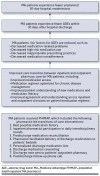Effect of the population health inpatient Medicare Advantage pharmacist intervention on hospital readmissions: A quasi-experimental controlled study
- PMID: 36840959
- PMCID: PMC10387964
- DOI: 10.18553/jmcp.2023.29.3.266
Effect of the population health inpatient Medicare Advantage pharmacist intervention on hospital readmissions: A quasi-experimental controlled study
Abstract
BACKGROUND: The population health inpatient Medicare Advantage pharmacist (PHIMAP) intervention is a pharmacist-led, transitions-of-care intervention that aims to reduce hospital readmissions among Medicare Advantage beneficiaries. PHIMAP includes inpatient pharmacist participation in interdisciplinary rounds, admission and discharge medication reconciliation, pharmacy staff delivery of discharge medications to the bedside, personalized discharge medication lists and counseling, and communication with outpatient pharmacists through an electronic health record. OBJECTIVE: To evaluate the effect of the PHIMAP intervention on unplanned 30-day same-hospital readmissions among Medicare Advantage patients. METHODS: Those included were patients admitted to a large urban academic medical center between May 2018 and March 2020 who had a Medicare Advantage plan and were aged at least 18 years. A 2-group, quasi-experimental design was utilized. Control patients received the usual care, which included a best possible medication history and a postdischarge phone call. A multivariable logistic regression model was estimated to predict unplanned 30-day same-hospital readmissions. This study was a Hypothesis Evaluating Treatment Effectiveness study. RESULTS: In total, 884 patients were included. The majority were White (59.0%), non-Hispanic (87.7%), English speaking (90.5%), and older adults (median age, 75 years; interquartile range, 70-83 years). We detected no statistically significant association between the PHIMAP intervention and unplanned 30-day same-hospital readmissions (odds ratio [OR] = 0.91, 95% CI = 0.56-1.52). After adjusting for patient demographics and clinical covariates, significant predictors of 30-day readmissions included the number of emergency department/inpatient visits within 180 days prior to index admission (OR = 1.40, 95% CI = 1.11-1.77); discharge to a post-acute care facility, such as an inpatient rehabilitation facility, long-term acute care facility, or skilled nursing facility (OR = 1.69, 95% CI = 1.06-2.66); hospital length of stay in days (OR = 1.04, 95% CI=1.01-1.07); and the Agency for Healthcare Research and Quality Elixhauser Comorbidity Index score (OR = 1.01, 95% CI = 1.01-1.02). CONCLUSIONS: Significant predictors of readmissions among Medicare Advantage beneficiaries were consistent with greater illness severity, including a recent history of prior hospital utilization, a discharge to post-acute care facility (vs home), a longer length of hospital stay, and a higher comorbidity burden. Although we detected no statistically significant association between PHIMAP and unplanned 30-day same-hospital readmissions, differences in study group assignment based on the day of hospital discharge (weekend vs weekday) was a noted limitation of this study. Future studies of inpatient pharmacist-led interventions should plan to minimize the risk of selection bias due to differences in the time of patient discharge. DISCLOSURES: This study was supported in part by the National Institute on Aging under award number R01AG058911 (to Pevnick) and the UCLA Clinical Translational Science Institute (UL1 TR001881). The sponsor had no role in the design and conduct of the study, nor the writing of this report.
Conflict of interest statement
This study was supported in part by the National Institute on Aging under award number R01AG058911 (to Pevnick) and the UCLA Clinical Translational Science Institute (UL1 TR001881). The sponsor had no role in the design and conduct of the study, nor the writing of this report.
Figures
Similar articles
-
Implementation and Effect of a Pharmacist-to-Pharmacist Transitions of Care Initiative on Ambulatory Care Sensitive Conditions.J Manag Care Spec Pharm. 2020 Apr;26(4):513-519. doi: 10.18553/jmcp.2020.26.4.513. J Manag Care Spec Pharm. 2020. PMID: 32223605 Free PMC article.
-
Assessing the impact of adding pharmacist management services to an existing discharge planning program on 30-day readmissions.J Am Pharm Assoc (2003). 2022 May-Jun;62(3):734-739. doi: 10.1016/j.japh.2021.12.005. Epub 2021 Dec 18. J Am Pharm Assoc (2003). 2022. PMID: 34975006
-
Inpatient pharmacists using a readmission risk model in supporting discharge medication reconciliation to reduce unplanned hospital readmissions: a quality improvement intervention.BMJ Open Qual. 2022 Mar;11(1):e001560. doi: 10.1136/bmjoq-2021-001560. BMJ Open Qual. 2022. PMID: 35241436 Free PMC article. Review.
-
Impact of pharmacist involvement in the transitional care of high-risk patients through medication reconciliation, medication education, and postdischarge call-backs (IPITCH Study).J Hosp Med. 2016 Jan;11(1):39-44. doi: 10.1002/jhm.2493. Epub 2015 Oct 5. J Hosp Med. 2016. PMID: 26434752 Clinical Trial.
-
Using a Transitional Care Program to Prepare Patients to Take Care of Themselves after Leaving the Hospital [Internet].Washington (DC): Patient-Centered Outcomes Research Institute (PCORI); 2019 May. Washington (DC): Patient-Centered Outcomes Research Institute (PCORI); 2019 May. PMID: 37856633 Free Books & Documents. Review.
References
-
- Neuman P, Jacobson GA. Medicare Advantage checkup. N Engl J Med. 2018;379(22):2163-72. doi:10.1056/NEJMhpr1804089 - PubMed
-
- Markossian TW, Suda KJ, Abderhalden L, Huo Z, Smith BM, Stroupe KT. Characteristics and medication use of veterans in Medicare Advantage plans. Am J Manag Care. 2018;24(5):247-55. - PubMed
MeSH terms
Grants and funding
LinkOut - more resources
Full Text Sources
Miscellaneous



